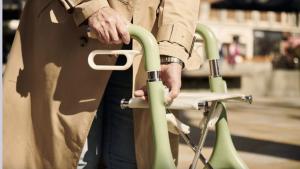Though the design of wearable devices has become more and more beautiful, the information they can provide is stagnating. This is according to Dr Riaan Conradie, Executive founder of LifeQ, a computational biology and information company which works with a research and development unit in Stellenbosch.
“It’s all old wine in new bottles,” says Conradie. “Old technologies are just being put in new designs. And while the physical design is an incredibly important aspect, functional design is really the key element.”
LifeQ aims to map the human body using data provided by wearable devices in order to inform lifestyle choices and predict and prevent disease. It focusses on six major areas to understand health and well-being: fitness, nutrition, sleep and stress, medical, health and data-mining.
Information is gathered externally and non-invasively, through simple sensing measures on the skin. The limiting factor for many existing devices is that they throw this type of measured data at users, but don’t aim to inform any behavioural changes. LifeQ combines these measurements with mathematical models to more holistic information to the user.
“In wearable tech these days a sleep device tells you as you wake up that you only had five hours sleep, and – by the way – it wasn’t very good sleep. Which you already know! That’s just adding insult to injury. It’s not helping anyone address the underlying issue. LifeQ takes the information, contextualises it and turns it into actionable insights. You know you had a bad night’s rest so what now? We try to answer the ‘what now’ questions.”
Finding new ways to monitor different body vitals (like blood pressure and blood glucose levels) takes up a lot of time in the LifeQ offices. Even measuring heartrate can prove difficult through a device worn on the body. For example, a watch trying to measure heartrate when a person is swinging their arms and moving around uses technology that can compensate for the background mess of information in order to provide a valuable sensor.
“The human body and all its molecules are the true sensors,” says Conradie. “They change as they are exposed to different environments. We simply have a lens to look inside the body and observe these changes.”
The technology that LifeQ designs takes the information gathered and puts it in context of very highly personalised information streams. The quality of your sleep is put alongside information about your nutrition, exercise, stress levels and basic vitals, giving you an understanding of where the problem might be coming from and where changes could be made.
“All these different things are highly integrative, and that’s the framework we’ve built,” says Conradie. “People aren’t sleeping enough, and sleep has a huge effect on basic nutrition.” A bad night’s sleep might result in a day of bad nutritional choices.
Conradie has a PhD in biochemistry with a specific focus on computational systems biology. It is a relatively new field with few specialists. Computational biology is very different to machine-developed data. Masses of information has been gathered on the human body and over the last 10 years mathematical models to describe human subsystems and physiology have been formed. What LifeQ does is collate all these different models into one comprehensive model of human health.
“I call data the new Lego, where data streams are bits of Lego. Lego on its own is not that functional, but you can interweave these data streams. I think we are at the point where we can’t even fathom what beautiful and informative streams will come out of this. Through our biological understanding we will be able to provide that context that people don’t even realise is available.”
The wearable technology industry is still in its infancy and LifeQ hopes to take wearables to the next level: to a point where they are so sophisticated that they can tell people what their current lifestyle is leading them towards, and how to make small changes to prevent health issues. The systems are highly personalised to the individual user, providing tailored solutions instead of generic health advice.
“Imagine how valuable it will be to be able to use applied analytics to forecast disease, even before its onset, so that you can act upon the information and prevent disease.”
Conradie uses weather to explain the progress of health data in wearables: originally you would go outside, get wet and know you need an umbrella. Then barometers were created that could reasonably predict weather in the short term.
“This is where wearables are today,” he says. But after the barometer came sophisticated models that use mathematical anaylsis to make concrete predictions about long-term weather patterns, and this is where LifeQ hopes to go with wearables.
The company was originally formed in 2010, but in the past few years they have been in what Conradie describes as “stealth mode”, building up their IP portfolios and maturing the sensors. LifeQ launched officially at the Consumer Electronics Show in Las Vegas in January 2015. The company employees a diverse range of specialists, including biologists, computer scientists, software architects and astrophysicists, and works with international partners.
The aim of the technology is to empower the individual, and to eventually put information in front of governments in the hopes of changing health-care policies.
“I’m a scientist – research is the thing that excites me the most, and I hope to drive change,” Conradie says.
LifeQ has no wearables on the shelves, but it is currently providing its techonology to three prominent international wearable tech companies, including First Alert which has won three awards for its devices. Conradie estimates that there will be 10 to 15 companies on their list in the next few months.
Its research is available through an open-source platform. “We don’t hold tight to our solutions,” says Conradie. “To truly reform health care and individualise health we need to enable others to join forces. We are an open platform; anyone can slot into our ecosystem. We don’t have any exclusivity.”










